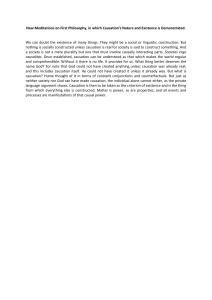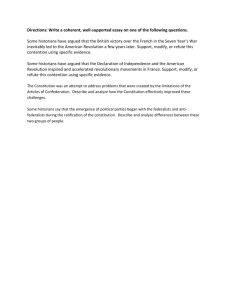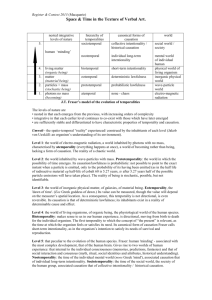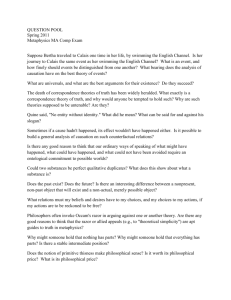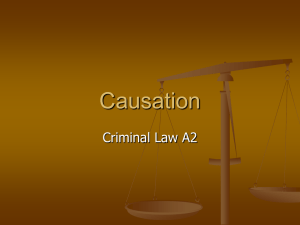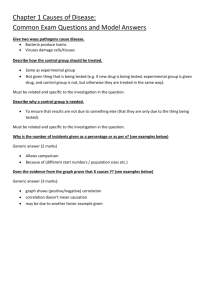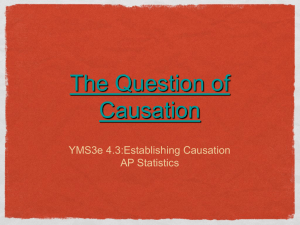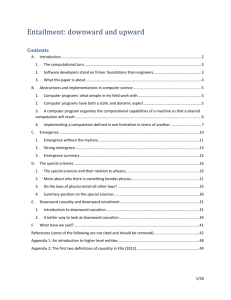APUSH Essay Prompts- Snyder Unit 1
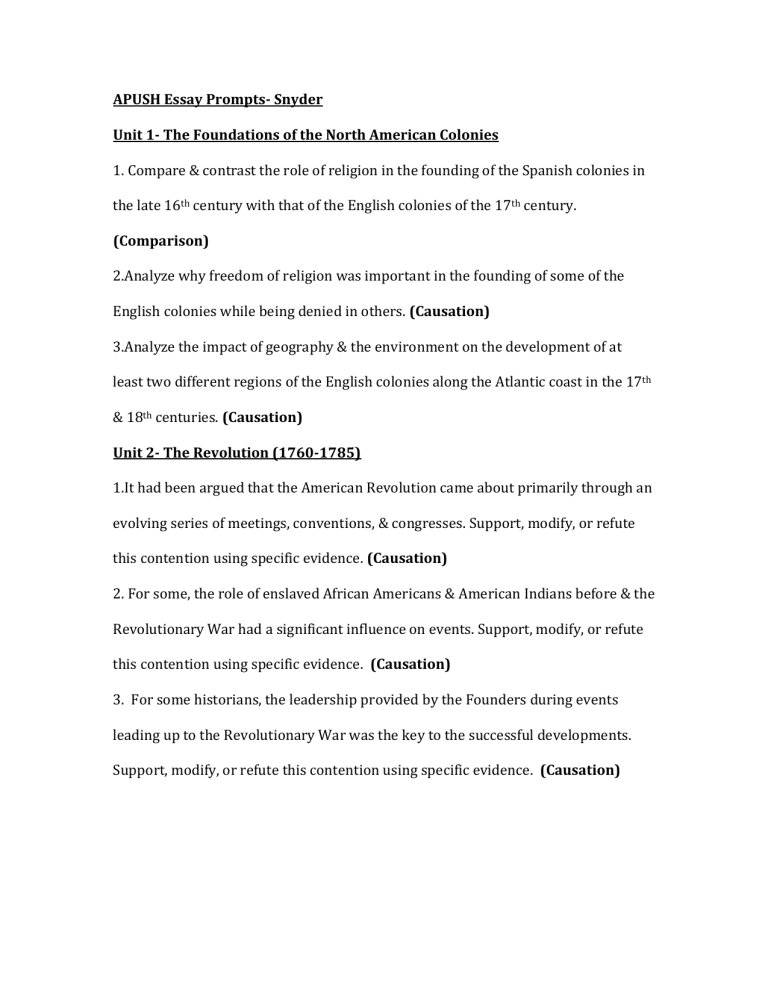
APUSH Essay Prompts- Snyder
Unit 1- The Foundations of the North American Colonies
1. Compare & contrast the role of religion in the founding of the Spanish colonies in the late 16 th century with that of the English colonies of the 17 th century.
(Comparison)
2.Analyze why freedom of religion was important in the founding of some of the
English colonies while being denied in others. (Causation)
3.Analyze the impact of geography & the environment on the development of at least two different regions of the English colonies along the Atlantic coast in the 17 th
& 18 th centuries. (Causation)
Unit 2- The Revolution (1760-1785)
1.It had been argued that the American Revolution came about primarily through an evolving series of meetings, conventions, & congresses. Support, modify, or refute this contention using specific evidence. (Causation)
2. For some, the role of enslaved African Americans & American Indians before & the
Revolutionary War had a significant influence on events. Support, modify, or refute this contention using specific evidence. (Causation)
3. For some historians, the leadership provided by the Founders during events leading up to the Revolutionary War was the key to the successful developments.
Support, modify, or refute this contention using specific evidence. (Causation)
Unit 3- The Federalists (1780-1800)
1. It has been argued that the United States Constitution came about primarily through an evolving series of meetings, conventions, & congresses. Support, modify, or refute this contention using specific evidence. (Causation)
2. For some the American Revolution was primarily an effort to maintain basic
British rights as opposed to establishing a new form of government. Support, modify, or refute this contention using specific evidence. (Causation)
3. Evaluate the extent to which the economic policies of Alexander Hamilton, including his views on banking during the early years of the republic contributed to fostering change in the United States banking system. (Continuity & Change Over Time)
Unit 4- The Jeffersonians (1800-1820)
1. Discuss the impact of territorial expansion on national unity between 1800 and
1850. (Causation)
2. “The Era of Good Feelings (1816-1824) marked the appearance of issues that transformed American politics in the next twenty years.” Assess the validity of this generalization. (Causation)
3. Some historians argue that Shay’s Rebellion tested the Articles of Confederation, which led to the Constitutional Convention & the call for a stronger central government. Support, modify, or refute this contention using specific evidence.
(Causation)
Unit 5- Jacksonian Democracy (1820-1850)
1. Analyze & evaluate the impact of Andrew Jackson’s economic policies, including his views on banking during the mid 19 th century. (Causation)
2. Compare & contrast the characteristics & the influences of the three major sections of the United States by the mid-19 th century. (Comparison)
3. Analyze the impact the Market Revolution had on internal migration during the first half of the 19 th century & the effect this migration had on the United States as a whole. (Causation)
Unit 6- Prelude to War (1845-1860)
1. Some historians argue that Manifest Destiny rekindled sectional tensions & led to the American Civil War that began in 1861. Support, modify, or refute this contention using specific evidence. (Causation)
2. Compare and contrast the ways in which supporters of slavery in the nineteenth century used legal, religious, and economic arguments to defend the institution of slavery. (Causation)
3. Analyze the emergence of utopian communities from the mid-1820s through the
1840s, and evaluate their success or failure. ( Causation)
Unit 7-The Civil War and Reconstruction (1860-1876)
1. Compare and contrast the moral arguments and political actions of those opposed to the spread of slavery in the context of TWO of the following. (Comparison)
Missouri Compromise
Mexican War
Compromise of 1850
Kansas-Nebraska Act
2. Analyze and evaluate the political, economic, and social reforms introduced in the
South between 1864 and 1877. To what extent did these reforms survive the Compromise of 1877?
3. “The South never had a chance to win the Civil War.”
Compare and Contrast economic and political factors of the North and South, Pre and Post Civil War. (Comparison)
Unit 8- The Gilded Age (1876-1900)
1. Compare & contrast the roles of the federal government as both promoter & regulator of industrial development & market capitalism from 1865 to 1900.
(Comparison)
2. Explain & analyze the impact of industrialization & expanding markets on the development of TWO of the following regions between 1865 & 1900.
(Periodization)
-Northeast/Midwest
-South
-West
3. Explain & analyze the impact of changes in transportation & marketing on both urban & rural consumers in the United States between 1865 & 1900. (Continuity &
Change Over Time)
Unit 9- The Populists and the Progressives (1880-1920)
1. Compare the objectives & strategies of organized labor & the Populist for challenging the prevailing economic beliefs & practices of the Gilded Age.
(Comparison)
2. Analyze & evaluate the ways TWO of the following groups changed their response over time to discrimination from 1830 to 1900. (Continuity & Change Over Time)
-African Americans
-American Indians
-Women
3. “The reform movements of the late nineteenth & early twentieth century focused primarily on the effects of the accelerating Industrial Revolution, especially its impact on the natural environment.” Support, modify, or refute the preceding interpretation using at least two reform movements & one environmental issue from the period 1880-1920 as evidence.” (Causation)
Unit 10- U.S. as a World Power (1880-1920)
1. Analyze the motivations of American expansion at the end of the 19 th century & the impact of this expansion on American economics & politics. Limit your answer to the time period 1865-1910. (Periodization)
2. Compare the debates that took place over American expansionism in the 1840’s with those that took place in the 1890’s, analyzing the similarities and differences in the debates of the two eras. (Comparison)
3. Analyze the relative influence of THREE of the following in the American decision to declare war on Germany in 1917. (Causation)
German naval policy
American economic interests
Woodrow Wilson’s idealism
Allied propaganda
America’s claim to world power
Unit 11- Boom and Bust (1920-1940)
1. Compare & contrast the beliefs & strategies of TWO of the following to address the needs of the U.S. economic system (Comparison)
-Progressives
-Economic conservatives of the 1920s & 1930s
-New Deal
2. Analyze the cause & effect of the Great Migration of African Americans from 1890 through 1930 & its social & economic impact on the development of 20 th century
America. (Causation)
3. “Although American writers of the 1920s and 1930s criticized American society, the nature of their criticisms differed markedly in the two decades.” Compare and contrast writers in both decades. (Comparison)
Unit 12- World War II (1920-1945)
1. Prior to American involvement in both the First and Second World Wars, the US adopted official policy of neutrality. Compare and contrast the policy and its modifications during the period 1914-1917 to the policy and its modifications during the period 1939-1941. (Comparison)
2. The United States decision to drop an atomic bomb on Hiroshima was a diplomatic measure calculated to intimidate the Soviet Union in the post-Second-
War era rather than a strictly military measure designed to force Japan’s unconditional surrender. (Causation)
3. “President Franklin D. Roosevelt was naïve and ineffective in his conduct of foreign policy from 1933 to 1941.”
Analyze this statement, do you agree or disagree with this statement? (Periodization)
Unit 13- A Cold Peace (1945-1960)
1. Compare and contrast the influence of TWO of the following on American-Soviet relations in the decade following the Second World War. (Comparison)
Yalta Conference
Communist revolution in China
Korean War
McCarthyism
2. Analyze how the decade of the 1950s deserves its reputation as an age of political, social, and cultural conformity? (Periodization)
3. Compare and contrast the ways the administrations of Presidents Eisenhower,
Kennedy, and Johnson maintain the policy of containment of communism developed during the Truman administration? (Comparison)
Unit 14- Contemporary America (1960-present)
1. Analyze how the Cold War altered the role of the United States in the world from
1945-1980. (Periodization)
2. Analyze the changes & continuity in the identity & roles of American women from
1945-1980. (change & continuity)
3. Compare & contrast the leadership & economic policies of presidents Ronald
Reagan & Franklin Roosevelt. (Comparison)
